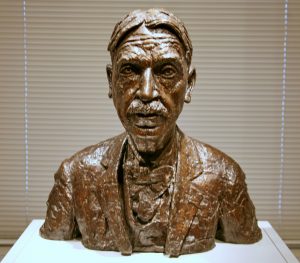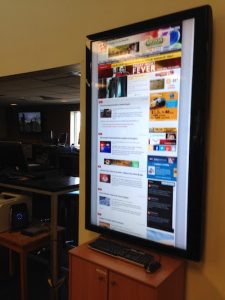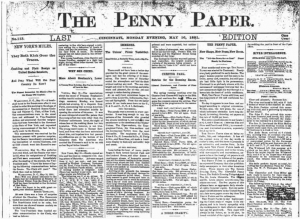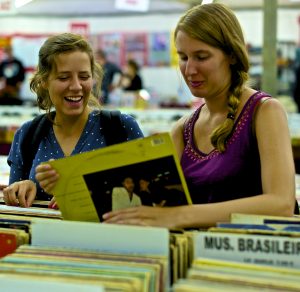1 Media, Society, Culture and You

“Society not only continues to exist by transmission, by communication, but it may fairly be said to exist in transmission, in communication.” — John Dewey in Democracy and Education, 1916
The purpose of this chapter is to define media, society and culture broadly. Additionally, the term “communication” is defined in its many forms. Chapters 2 and 3 deal with communication theory in more detail. Digital culture is covered in depth in Chapter 2. We will discuss media literacy and media studies in Chapter 3, but we have to learn to walk before we run, as the saying goes.
The Role of Mass Media in Society
More than one hundred years ago, John Dewey wrote in Democracy and Education that society is not only supported by various forms of communication but also enveloped in communication. Dewey reiterated what philosophers and scholars had noted for centuries: small groups, larger communities and vast institutions — all the things that make up a society — function in relation to how communication flows within and between groups.
There are different forms of communication. At the broadest level, communication is an exchange of meaning between people using symbols. The most common symbols we use are verbal and written words, but there are also many forms of nonverbal communication such as American Sign Language. What sign language, verbal communication and written communication have in common is the use of abstract symbols to convey meaning. Whether you say “thank you” in face-to-face communication, send someone a card with the words “thank you” written on it, or use nonverbal cues to express thanks, the meaning is the same.

Interpersonal communication generally refers to the exchange of meaning between two or more people on a personal, often one-on-one, level. Interpersonal communication can be verbal or nonverbal. Most often, it happens in face-to-face settings. It differs from mass communication, which involves sharing meaning through symbolic messages to a wide audience from one source to many receivers. Sometimes, particularly in computer-mediated communication, messages conveyed using computers, it can be difficult to tell the difference between interpersonal communication and mass communication because individuals can send messages intended only for other individuals that might quickly reach large numbers of people. Social media platforms are often structured in ways that allow interpersonal messages to “go viral” and become mass messages whether the original sender intended to address a mass audience or not.
It is not the type of message that determines interpersonal or mass communication. It is the way the message is distributed and the relationships between sender and receiver(s). This text will continue to grapple with the overlap of interpersonal communication and mass communication structures on networked communication platforms, but first, another form of communication commonly studied in academic settings should be introduced.
Organizational communication is the symbolic exchange of messages carrying specific meaning for members belonging to formal organizations. In practical terms, it is the internal communication that helps governments, businesses, schools and hospitals to run.
People working together in organizations get usually things done by communicating directly with one another or in small groups. Organizations cannot function without communication. Organizational communication effectiveness can influence the success or failure of businesses and other social institutions. Thus, communication does not merely happen within organizations; it is an essential part of the way they are structured. Organizational communication is a separate field of study, introduced well in this YouTube video.
Successful communication, whether intended for personal use, for use within an organization, or for a wide audience, can help people to understand each other and to get things done.
If good organizational communication is necessary for groups to function with a formal purpose, mass communication is essential for societies to function. Societies are made up of formal organizations of various sizes. Usually, the larger the group, the more complex its communication structures.
Communication structure refers to a combination of information and communication technologies (ICTs), guidelines for using those technologies, and professional workers dedicated to managing information and messages. In the mass communication field, communication structures are more than computers and transmission networks. The guidelines for using networks to create and distribute messages for mass consumption are a matter of corporate policy as well as law.
It has been noted that a society is made up of small groups, larger communities, and vast institutions. A more complete definition of the term comes from the field of sociology. A society is a very large group of people organized into institutions held together over time through formalized relationships. Nations, for example, are made up of formal institutions organized by law. Governments of different size, economic institutions, educational institutions and others all come together to form a society.
By comparison, culture — the knowledge, beliefs, and practices of groups large and small — is not necessarily formalized. Culture is necessary for enjoying and making sense of the human experience, but there are few formalized rules governing culture.
Mass communication influences both society and culture. Different societies have different media systems, and the way they are set up by law influences how the society works. Different forms of communication, including messages in the mass media, give shape and structure to society. Additionally, mass media outlets can spread cultural knowledge and artistic works around the globe. People exercise cultural preferences when it comes to consuming media, but mass media corporations often decide which stories to tell and which to promote, particularly when it comes to forms of mass media that are costly to produce such as major motion pictures, major video game releases and global news products.
More than any other, the field of mass communication transmits culture. At the same time, it helps institutional society try to understand itself and whether its structures are working.
The Mass Media Dynamic
The mass media system is an institution itself. What sets it apart is its potential to influence the thinking of massive numbers of individuals. In fact, the ideas exchanged in organizational communication and interpersonal communication are often established, reinforced or negated by messages in the mass media. This is what it means for societies “to exist in transmission, in communication.” Different types of communication influence each other.
But the mass media are also shaped and influenced by social groups and institutions. This is the nature of the mass media dynamic.
Individuals and groups in society influence what mass media organizations produce through their creativity on the input side and their consumption habits on the output side. It is not accurate to say that society exists within the mass media or under mass media “control.” Social structures are too powerful for mass media to completely govern how they operate. But neither is it accurate to say that the mass media are contained within societies. Many mass media products transcend social structures to influence multiple societies, and even in societies that heavily censor their mass media the news of scandals and corruption can get out. The mass media and society are bound together and shape each other.
Almost everything you read, see and hear is framed within a mass media context; however, mere familiarity is no guarantee of success. Products in the mass media that fail to resonate with audiences do not last long, even if they seem in tune with current tastes and trends.
The Mass Communication Origin Story
In his book, John notes how, in the early 20th century, the mass media were beginning to connect large institutions in new ways. The production of mass media messages accelerated with the development of the telegraph and the popular newspaper. The spread of telegraph technology that began in the mid-1800s continued through the early 1900s to network the globe with a nearly instantaneous information transmission system. Much of the growth of newspapers occurred as a result of improvements in telegraph technology.

Thus, a primary function of the global mass communication system is to save time. People have a need to understand what is going on in the world, and they desire entertainment. Global electronic telecommunication networks collapse space by transmitting messages in much less time than the older, physical delivery systems.
The dynamic between society and mass media that is so prevalent today developed throughout the 20th century. Starting near the end of the 1800s, communication flows began to move at electronic speeds. More people knew about more things than ever before, but scholars are quick to point out that communication is not synonymous with understanding.
Dewey wanted to focus on educating people so that they could live and work well in societies heavily shaped by global telecommunication networks. For him, education was the meaning of life and the global information and communication system needed to be molded into an educational tool. Many of us still hold out hope for Dewey’s educational goals, but as ICTs have advanced over the past century or two, it has become clear that the mere existence of global mass communication networks does not ensure that societies will learn to coexist and thrive.
This can be difficult for people to acknowledge. Shortly after the widespread dissemination of the telegraph, the radio, broadcast television and public internet access, some form of communication utopia was imagined or even expected. The telegraph collapsed space. Radio enabled instantaneous mass communication. Television brought live images from one side of the globe to the other for even larger mass audiences, and internet access gave individuals the power to be information senders, not just receivers. At each step hope and imagination flourished, but social and cultural clashes persisted. Communication systems can be used as weapons. The evolution of mass communication tools is the story of increased capacity to do the same good and evil things people have always done in societies and between them.
Looking beyond technological utopianism — the idea that new technologies (particularly ICTs) will lead to greater social understanding and better conditions for the global population — we are left with a tedious but massively meaningful project. We must find ways to coexist with other societies even as we are constantly aware of our differences and of possible threats that may have existed before but now are much easier to see.
Perhaps if we are to make the best of our digital global communication network, it would help to track the evolution of different forms of mass communication. This text very briefly touched on the continuum from telegraph to widespread internet adoption, but the first mass medium was ink on paper.
The First Mass Medium
The first global medium, besides the spoken word, was neither the internet nor the telegraph. In fact, it was not a mass medium at all. It was paper. Via trade routes, messages in the form of letters moved around the world in a matter of weeks or months. It was global communication, but it was slow.
The development of a global telegraph network made it possible for messages to spread in minutes. When the telegraph was wed to mass-consumed newspapers, the world saw the rise of fast, global, mass communication that had the power to potentially influence large groups of people at once.
Books transmitted messages widely and inspired literacy, but they did not establish a channel for consistent, timely communication meant for mass audiences. After the Gutenberg printing press was developed around 1440, the Gutenberg Bible was slowly mass produced and disseminated around the Western world. It opened up access to sacred texts that had been bound up for centuries by large institutions like the Roman Catholic Church, and its dissemination helped fuel the Protestant Reformation. Still, it was an outlier. Most other books, even those that were mass produced from around the 1500s to the 1800s were not disseminated as widely as the Gutenberg Bible. They were simply too expensive.
Nevertheless, mass literacy slowly paved the way for mass newspaper readership to emerge in the 20th century. After the telegraph was invented and developed for wide-scale use and after the cost of printing newspapers dropped, publishers could share news from around the globe with mass audiences. The newspaper, specifically the penny press, was the first mass medium.

What distinguished the penny press was affordability. These papers were published in tabloid format, which used small-sized pages and was cheaper to produce. Penny papers were written for and read by working class audiences starting in about the 1830s. They covered all manner of current events. Soon, major institutions such as political parties and unions developed their own papers to cover the topics that suited their agendas and to promote the cultural values that they held dear.
Mass Media Growth and Consolidation
As mass production of all sorts of manufactured goods grew during the 20th century, so did advertising budgets and the concept of brands. Brand advertising became fuel for the mass media, and as profitability rose, newspapers were bought up and organized into chains throughout the 20th century. Many newspapers grew their audience as they merged.
Partisan papers gave way to a brand of news that strived for objectivity. The profit motive mostly drove the change. To attract a mass audience, newspapers had to represent various points of view. This pushed some of the most opinionated citizens, particularly strong advocates for workers, to the fringes of mass discourse. Some advocates developed alternative media offerings. Others went mostly unheard or plied their craft directly in politics.
At the same, throughout much of the 20th century, the journalism workforce became more professionalized. Professional norms, that is the written and unwritten rules guiding behavior decided on by people in a given field, evolved. Many full-time, paid professional journalists stressed and continue to stress the need to remain detached from the people they cover so that journalists can maintain the practice and appearance of objectivity. Journalists emphasized objectivity in order to remain autonomous and to be perceived as truthful. The norm of objective reporting still strongly influences news coverage in newspapers as well as on most mainstream radio and television news networks.
That being said, the practice of maintaining objectivity is being called into question in our current hyper-partisan political media environment. Other strategies for demonstrating truthfulness require journalists to be transparent about how they do their work, about who owns their media outlets, and about what investments and personal views they may have. Chapter 9 covers news norms and their evolution in greater detail.
At the heart of the ethical discussion for professional journalists is a sort of battle between the need to be autonomous to cover news accurately with minimal bias and the need to be socially responsible. Social responsibility in the study of journalism ethics is a specific concept referring to the need for media organizations to be responsible for the possible repercussions of the news they produce. The debate goes on even as more and more platforms for mass communication are developed.
Beyond advancements in ink-on-paper newspapers (including the development of color offset printing), technological developments have contributed to the diversification of mass media products. Photography evolved throughout the 20th century as did motion picture film, radio and television technology. Other mass media presented challenges and competition for newspapers. Still, newspapers were quite a profitable business. They grew to their greatest readership levels in the middle-to-late 20th century, and their value was at its high point around the turn of the 21st century. Then came the internet.
Stewing in our Own Juices
With the rise of global computer networks, particularly high-speed broadband and mobile communication technologies, individuals gained the ability to publish their own work and to comment on mass media messages more easily than ever before. If mass communication in the 20th century was best characterized as a one-to-many system where publishers and broadcasters reached waiting audiences, the mass media made possible by digital information networks in the twenty-first have taken on a many-to-many format.
For example, YouTube has millions of producers who themselves are also consumers. None of the social media giants such as Facebook, YouTube, Instagram, Qzone and Weibo (in China), Twitter, Reddit or Pinterest is primarily known for producing content. Instead, they provide platforms for users to submit their own content and to share what mass media news and entertainment companies produce. The result is that the process of deciding what people should be interested in is much more decentralized in the digital network mass media environment than it was in the days of an analog one-to-many mass media system.
The process of making meaning in society — that is, the process of telling many smaller stories that add up to a narrative shared by mass audiences — is now much more collaborative than it was in the 20th century because more people are consuming news in networked platforms than through the channels managed by gatekeepers. A mass media gatekeeper is someone, professional or not, who decides what information to share with mass audiences and what information to leave out.
Fiction or non-fiction, every story leaves something out, and the same is true for shows made up of several stories, such as news broadcasts and heavily edited reality television. Gatekeepers select what mass audiences see, and then edit or disregard the rest. The power of gatekeepers may be diminished in networks where people can decide for themselves what topics they care most about, but there is still an important gatekeeping function in the mass media since much of what is ultimately shared on social media platforms originates in the offices and studios of major media corporations.
On social media platforms, media consumers have the ability to add their input and criticism, and this is an important function for users. Not only do we have a say as audience members in the content we would like to see, read and hear, but we also have an important role to play in society as voting citizens holding their elected officials accountable.
If social media platforms were only filled with mass media content, individual user comments, and their own homegrown content, digitally networked communication would be complex enough, but there are other forces at work. Rogue individuals, hacker networks and botnets — computers programmed to create false social media accounts, websites and other digital properties — can contribute content alongside messages produced by professionals and legitimate online community members. False presences on social media channels can amplify hate and misinformation and can stoke animosity between groups in a hyper-partisan media age.
Around the world, societies have democratized mass communication, but in many ways, agreeing on a shared narrative or even a shared list of facts is more difficult than ever. Users create filter bubbles for themselves where they mostly hear the voices and information that they want to hear. This has the potential to create opposing worldviews where users with different viewpoints not only have differing opinions, but they also have in mind completely different sets of facts creating different images about what is happening in the world and how society should operate.
When users feel the need to defend their filtered worldviews, it is quite harmful to society.
De-massification
The infiltration of bots on common platforms is one issue challenging people working in good faith to produce accurate and entertaining content and to make meaning in the mass media. De-massification is another. Professionals working on mass-market media products now must fight to hold onto mass audiences. De-massification signifies the breakdown of mass media audiences. As the amount of information being produced and the number of channels on which news and other content can be disseminated grows exponentially, ready-made audiences are in decline.
In the future, it is anticipated that audiences, or fan bases, must be built rather than tapped into. One path to growing audiences in digital networks is to take an extreme point of view. Producers of news and entertainment information on the right and left of the political spectrum often rail against mainstream media as they promote points of view which are more or less biased. This kind of polarization along with the tendency of social media platforms to allow and even encourage people to organize along political lines likely contributes to de-massification as people organize into factions.
The future of some mass communication channels as regular providers of shared meaning for very large audiences is in question. That said, claims that any specific medium is “dead” are overblown. For example, newspaper readership, advertising revenue and employment numbers have been declining for about 25 years, but as of 2018, there are still more than 30 million newspaper subscribers. Mass audiences are shrinking and shifting, but they can still be developed.
Convergence
As mass audiences are breaking up and voices from the fringe are garnering outsized influence, the various types of media (audio, video, text, animation and the industries they are tied to) have come together on global computer and mobile network platforms in a process called convergence.

It is as though all media content is being tossed into a huge stew, one that surrounds and composes societies and cultures, and within this stew of information, people are re-organizing themselves according to the cultural and social concerns they hold most dear.
According to one hypothesis, in a society dominated by digital communication networks, people gather around the information they recognize and want to believe because making sense of the vast amount of information now available is impossible.
This text covers several mass media channels including social media, film, radio, television, music recording and podcasting, digital gaming, news, advertising, public relations and propaganda because these are still viable industries even as the content they produce appears more and more often on converged media platforms.
What we see emerging in networked spaces is a single mass media channel with a spectrum of possible text, photo, audio, video, graphic and game elements; however, the sites of professional production still mostly identify as one particular industry (such as radio and recorded music, film, television, cable television, advertising, PR, digital advertising or social media). Some of these are “legacy” media that have existed as analog industries prior to convergence, while others originated in digital media environments.
For the foreseeable future, we should expect legacy media producers to continue to hold formidable power as elements of larger media conglomerates, which acquired many media companies as a result of industry deregulation. We should also expect audiences to continue to fragment and digital media start-ups trying to build audiences out of fragmented communities to be common even if they are difficult to sustain.
What this means for social structures and for cultural production is disruption, limited perhaps by legacy media traditions and corporate power.
Melding Theories
The world of mass media has witnessed the convergence of media content on digital platforms, the ability of individuals to engage in one-to-many communication as though they were major broadcasters, and the emergence of structures that allow for many-to-many communication. These developments force us to rethink how separate interpersonal, organizational and mass communication truly are.
From a theoretical standpoint, these are well-established approaches to thinking about communication, but in practice, certain messages might fit into multiple categories. For example, a YouTube video made for a few friends might reach millions if it goes viral. Is it interpersonal communication, mass communication or both? Viral videos and memes spread to vast numbers of people but might start out as in-jokes between internet friends or trolls. The message’s original meaning is often lost in this process. In a networked society, it can be difficult to differentiate between interpersonal and mass communication. For our purposes, it will be helpful to consider the message creator’s intent.
As a user, it is essential to realize the possibility that interpersonal messages may be shared widely. As professionals, it also helps to realize that you cannot force a messge to go viral, although most social media platforms now engage in various kinds of paid promotion where brands and influential users can pay to have their content spread more widely more quickly.

We must also understand that advertisers treat digital communication platforms much the same way whether they appear to users to be interpersonal or mass media environments. Users can be targeted down to the individual on either type of platform, and advertisers (with the help of platform creators), can access mass audiences, even when users are intending only to participate on a platform for purposes of interpersonal communication.
Scholars are still working to define how these platforms mix aspects of interpersonal and mass communication. Here is one takeaway: If you are not paying to use a platform like Facebook, Twitter, YouTube (Google), Instagram or Snapchat, you are the product. It is your attention that is being sold to advertisers.
The Big Picture
Society functions when the mass media work well, and we tend not to think about the technologies or the professionals who make it all possible. Interpersonal communication can function with or without a massive technological apparatus. It is more convenient, though, to be able to text each another. When interpersonal communication breaks down, we have problems in our relationships. When organizational communication breaks down, it creates problems for groups and companies. But when mass communication breaks down, society breaks down.
Cultural Production
There is another way of looking at the mass media that needs to be mentioned after looking in some depth at the structural changes going on in and around the field of mass communication. Mass media channels are also huge engines of cultural production. That is, they make the entertainment that helps us define who we are as large and small groups of people. To quote from Dead Poets Society: “We read and write poetry because we are members of the human race, and the human race is filled with passion. Medicine, law, business, engineering, these are noble pursuits and necessary to sustain life. But poetry, beauty, romance, love, these are what we stay alive for.” If you replace “reading and writing poetry” with “creating culture,” you get a sense of the importance of cultural production. We can define culture as a collection of our knowledge, beliefs and practices. In practice, culture it how we express ourselves and enjoy life’s experiences.
In media, there are three main types of cultural works, those associated with “high” culture, popular culture and folk culture. (Some scholars discuss “low” culture, but it is argued here that “low culture” is just another way of describing the low end of pop culture.)
High culture is arguably the best cultural material a society has to offer. Economic class often comes into play in defining what is “high culture” and what is not.
Pop culture is the vast array of cultural products that appeal to the masses.
Folk culture refers to cultural products borne out of everyday life identifiable because they usually have practical uses as well as artistic value. It is often associated with prehistoric cultures, but that is because the folk culture, pop culture and high culture of prehistoric peoples were often one and the same. Their best art may also have been an everyday object like a bowl or a basket or a doll or a mask. Don’t confuse prehistoric art with modern folk art.
Modern folk art has the specific quality of trying to capture what is both beautiful and useful in everyday life.
Folk music tends to rely on “traditional” sounds and instruments. Topically, it focuses on the value of everyday existence. Folk music is often built around narratives that carry morals much the same way fairy tales do. Fairy tales are probably the best example of folk literature.
So much of the interpretation and the value of cultural production is culturally relative. This means that an object or work’s value is determined by perceptions of people in different cultural groups.
In modern society, mass media often drive our perceptions. It is important to recognize that different cultures have different moral values and to acknowledge that some practices should be universally abhorred and stopped, even if they are partially or wholly accepted in other cultures.
The relationship between culture and mass media is complex; it is difficult to distinguish modern culture from how it appears in the various mass media. Culture in the developed world is spread through mass media channels. Just as society forms and is formed in part by messages in the mass media, so it goes with culture. Cultural products and their popularity can influence which media channels people prefer. Conversely, changes in media and ICTs can lead to changes in how we produce culture.
When we discuss digital culture in the next chapter, we will continue to break down different levels of culture and the relationship between cultural forms and mass communication in the networked communication age. To begin to understand the mass media, their role in society and how they shape culture and are shaped by cultural preferences, it helps to think about how the mass media may influence you.

